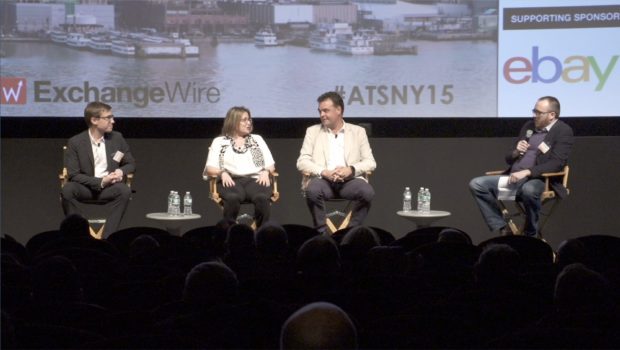The Publisher Programmatic Model
by Rebecca Muir on 19th Nov 2015 in News

Earlier this month (3 November), at ATS New York, a trio of thought leaders discussed how publishers can fight back against Google and Facebook, the rise of private marketplaces and how to ensure users understand the value of free online content and the role played by advertising. The panel was moderated by ExchangeWire’s CEO, Ciaran O’Kane.
The panellists were:
– Romain Job, general manager US, SmartAdServer
– Jana Meron, VP of programmatic & data strategy, Business Insider
– John Snyder, CEO, Grapeshot
 Meron (pictured right) kicked things off by describing the challenge facing today’s online publishers, she said: “It’s a big challenge, what we’re doing is trying to create unique first- and second-party audiences we can use cross device. Not everyone is registered, so we may not have device IDs, but we can target unique audiences on mobile. [Data is] stitched together, but all within the same realm. We know who buys, and what they buy and we can combine it with keyword targeting.”
Meron (pictured right) kicked things off by describing the challenge facing today’s online publishers, she said: “It’s a big challenge, what we’re doing is trying to create unique first- and second-party audiences we can use cross device. Not everyone is registered, so we may not have device IDs, but we can target unique audiences on mobile. [Data is] stitched together, but all within the same realm. We know who buys, and what they buy and we can combine it with keyword targeting.”
Nobody buys mobile, they buy Facebook
When it comes to mobile, Facebook is quite possibly the only real player, from a publisher perspective.
 Snyder (pictured left) argued: “Facebook has unique logins and a huge audience; they are selling custom audiences. How can publishers fight back? Through audience profiling and then finding that audience online at scale. You have to be accurate.” Snyder continued to fight for premium publishers when it comes to brand spend, arguing that context is better on premium publishers’ sites and that there is a better feedback loop when it comes to understanding performance.
Snyder (pictured left) argued: “Facebook has unique logins and a huge audience; they are selling custom audiences. How can publishers fight back? Through audience profiling and then finding that audience online at scale. You have to be accurate.” Snyder continued to fight for premium publishers when it comes to brand spend, arguing that context is better on premium publishers’ sites and that there is a better feedback loop when it comes to understanding performance.
Continuing the same thread, Meron said: “Context is a weapon you can fight back with. You’re not comparing apples to apples when you say ‘how can a publisher compete with Google or Facebook’? Publishers have context and have an audience who are not seeing their friends’ pictures of their kids. In other words, they’re in the right frame of mind to receive messaging.” Meron encouraged the ATS audience to differentiate between Google, Facebook, and independent publishers, she said: “Don’t see it as a competition, you’re buying us for something totally different, even with audience buys."
Compare and contrast: US & UK
 Job (pictured left) told the audience: “The US marketplace is worse than the UK; it is owned by a few big providers of mobile advertising. People who work with other vendors are successful because there is a lot of fatigue already; the walls are pretty high.” He continued: “What we see in the EU is that branding on mobile apps is working and we’re generating most of our revenue through programmatic. We do a lot of PMP deals for in-app specific content; it’s where the demand is. In the US, most publishers gave up on their app because they didn’t have the right tools to monetise traffic. In the US, everything is mobile web.”
Job (pictured left) told the audience: “The US marketplace is worse than the UK; it is owned by a few big providers of mobile advertising. People who work with other vendors are successful because there is a lot of fatigue already; the walls are pretty high.” He continued: “What we see in the EU is that branding on mobile apps is working and we’re generating most of our revenue through programmatic. We do a lot of PMP deals for in-app specific content; it’s where the demand is. In the US, most publishers gave up on their app because they didn’t have the right tools to monetise traffic. In the US, everything is mobile web.”
Private marketplaces: Premium trading or premium waste of resource?
Moving on to talk about native and private marketplaces (PMPs), Job said: “It is happening as we speak – over the last few months the largest part of revenue on our supply-side platform (SSP) [is coming] from PMPs – premium programmatic is happening right now. Native integration of SSPs with ad servers makes content available programmatically.”
Snyder spoke of the pitfalls of PMPs, he said: “Lots of deals are set up but not trafficked all the way through. Publishers are not happy that expected revenue didn’t come through. There are horrible workflows to understand yield what deals are working. Human time is being wasted. PMPs are not programmatic, they are time intensive.”
Job replied with solutions for the future, he said: “The programmatic stack needs to be directly integrated in an ad server. Integration of tech is hard, and sometimes doesn’t work, but building natively in the ad server makes PMP deals easier”.
Meron concluded the discussion about PMPs by saying: “It’s just automated workflow. It takes management, it’s not automated the way programmatic guaranteed is. PMPs are an auction, there are auction dynamics that advertisers need to know about – it takes work, but it is an auction.”
Users don’t understand the value on online content
Ad blockers have provided people with a way to stand up and be counted and tell the online advertising industry "you’re getting it wrong". By installing an ad blocker, you’re sending a clear message that advertising is not working for you.
Meron said: “The user doesn’t understand the trade off. Content costs money and we’ve made it available for free. Plenty of people have not thought about the user experience and have made the user say ‘I don’t want any part of this’. Publishers who pride themselves on user experience are suffering as a result.”
Meron commented on the success of mobile being down to allowing users more choice, she said: “The ability to get out of it [advertising] makes mobile good.”
Snyder spoke of how the industry can address the problems it has created, he said: “There is a certain amount of ad blindness when you see the same ad format year after year. Perhaps people are turning off because of that. There will be a pivot to content marketing; brand story needs to be interwoven, not just a sponsorship area, but weave advertising in with editorial. A mix of paid content with editorial will get over ad blindness.”
Job raised a different perspective, he said: “For some reason when we talk about ad blockers we talk about the user experience, but people have ad blockers because they don’t want to be tracked. We should be thinking about what we can do to avoid profiling users who don’t want to be tracked, but still deliver relevant advertising.”
Give users control
Meron spoke of her own experience of taking control of her online profile to make advertising work for her. She learnt about user control after buying her husband a present online and subsequently being targeted by male-oriented ads. When it came to moving house, she updated her address, with cookies enabled in-order to let advertisers know she had moved. Thus proving that when you know how, there is a way for users to game the system, the problem is – very few know how.
Snyder drew comparisons with paid search, he said: “In paid search there are ads at the top of search results – that advertising is more relevant because I have said what I want. Profiling means you know what users want. To what extent will consumers be involved in saying what they want in display?”
Ad BlockingAd ServerCross-ChannelDisplayExchangeMobileProgrammaticPublisherSupply SideTargeting








Follow ExchangeWire